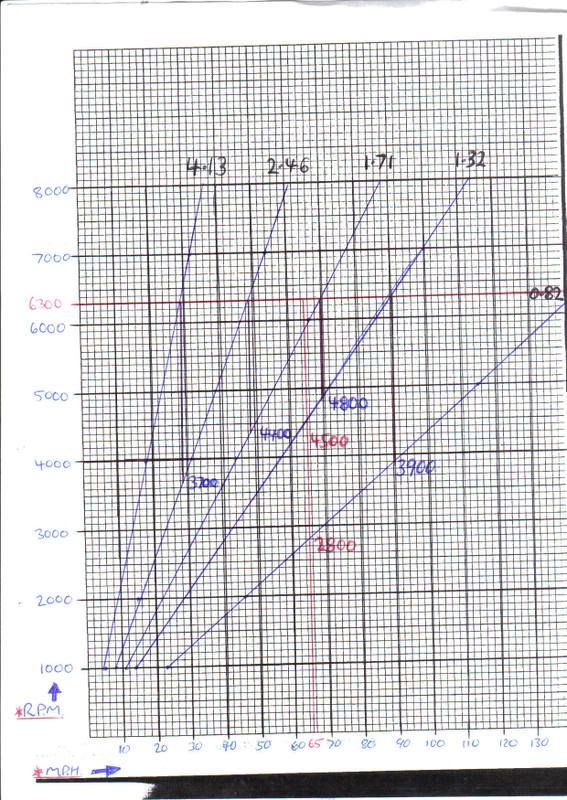
What type of Gear Box?
old skool - November 26th, 2008 at 07:26 PM
 Can anybody tell me what kind of Gear boxes will fit a 1800cc .I
think the motor is a 1800 (Engine number AP008761) twin carb. for a 1973 kombi.
Can anybody tell me what kind of Gear boxes will fit a 1800cc .I
think the motor is a 1800 (Engine number AP008761) twin carb. for a 1973 kombi.
And what affect would it have on travelling speed, power etc if used 1600,1700, 2000 gearbox and would they even fit?.
dangerous - November 27th, 2008 at 03:38 PM
1600 box will have to get the input shaft changed to the longer 1700/1800/2lt one,
and possibly the bell housing if your 1600 is an early one without mounting ears on top.
2lt box will work but you must position it correctly, and use 2lt starter motor,
because these are a longer box at the front(8mm) and back(10mm) of the axle centre line.
This way your shifter can work, and your engine position should be correct.
Assuming a tyre of 25" in diameter the rpm at 100km/h will be:
1600..........3680rpm.
1800..........3600rpm.
2lt..............3365rpm.
some later 1600/1700 boxes used 5.429 diff,
and these will be 3715 rpm at 100km/h.
old skool - November 27th, 2008 at 06:43 PM
Thank Dave, firt for being the only one answer the question, and second for the information
Thanks agan.
VWCOOL - November 27th, 2008 at 07:42 PM
...you won't need a third! 
trickysimon - November 27th, 2008 at 07:49 PM
Can I ask how you calculate that Dave?
Could you tell me what rpm my 1600 would be doing with a 1300 gear box at 100km/h.
195/65 or 75 cant remember/14
Phil74Camper - November 27th, 2008 at 08:49 PM
The formula is:
km/h = (rpm x circ x 0.06) / (gear x final)
where
rpm = engine rpm
circ = tyre circumference in metres
gear = gear ratio
final = diff ratio
To use an example, say you have stock 1200 Beetle with 155/75R15 tyres. Circ works out as 1.927 metres, top gear is 0.89 and diff is 4.375. At 1,000
rpm, the km/h is (1000 x 1.927 x 0.06) / (0.89 x 4.375) = 29.69 km/h.
Then to work out the rpms at any speed, divide the speed (say 100 km/h) by the 29.69 and multiply by 1000, which in this case equals 3,368 rpm.
Tyre circumference (m) can be estimated two ways - roughly (height in mm x 0.003), or more accurately by calculating the tyre profile height and
adding it the wheel diameter. A 195-60 R15 tyre, for example, will have a profile height of 60% of 195 (117mm). Add this to half the wheel diameter
(half of 15", or 190.5 mm), and you get a tyre height radius of 307.5 mm. Multiply by 2 pi (6.28) and divide by 1000, and you get a circumference of
1.931 metres. Or you could run a cloth measuring tape around the wheel!
I haven't worked this out in inches or feet or miles or furlongs or whatever as I hate them. Metric is much easier.
trickysimon - November 27th, 2008 at 09:40 PM
Dam, I thought had seen the last of maths when I finished school 
Guess its out with the calculator then 
Thanks
hellbugged - November 27th, 2008 at 09:45 PM
http://www.et-studios.com/motorsports/gears/gears.html
http://www.1010tires.com/TireSizeCalculator.asp
from there grab a sheet of graph paper and away you go!

Joel - November 27th, 2008 at 09:57 PM
bah just chuck in 3.88 and a 0.82 4th and listen to that baby barely idling at 100km/h 
 Can anybody tell me what kind of Gear boxes will fit a 1800cc .I
think the motor is a 1800 (Engine number AP008761) twin carb. for a 1973 kombi.
Can anybody tell me what kind of Gear boxes will fit a 1800cc .I
think the motor is a 1800 (Engine number AP008761) twin carb. for a 1973 kombi.



